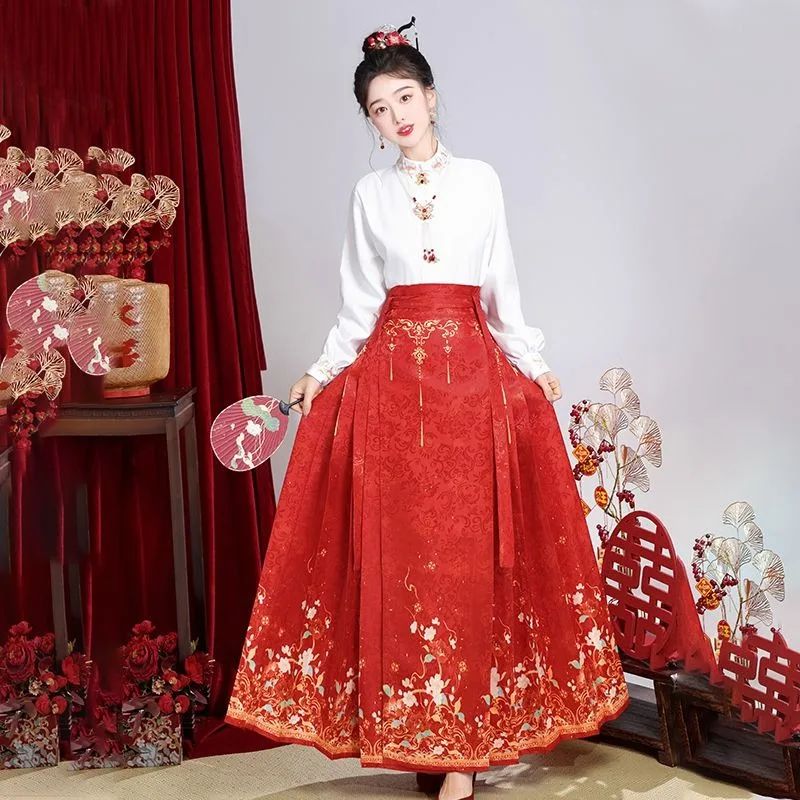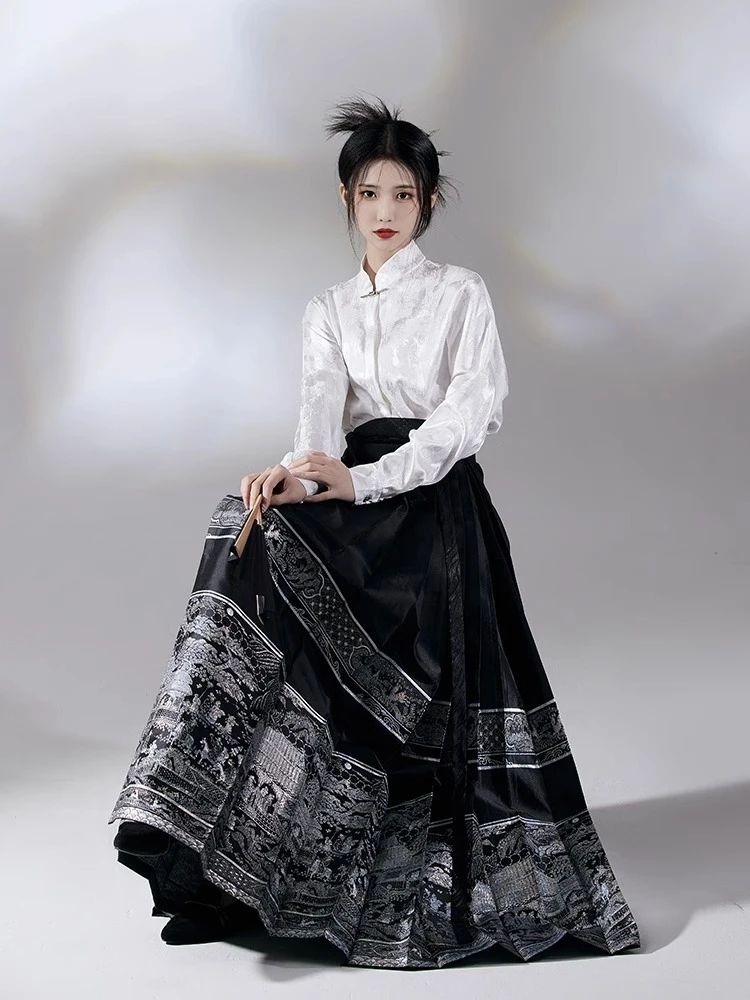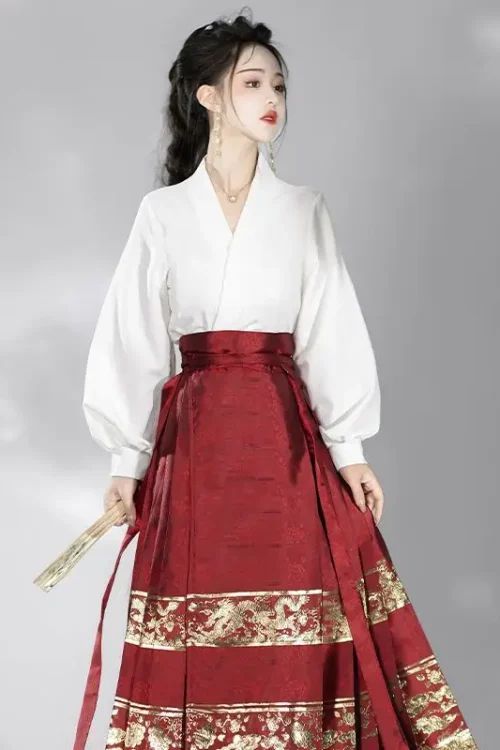Revisiting the Mamianqun: The Skirt that Represents Chinese Elegance
Historical Origins
The mamianqun, a traditional Chinese skirt, has captivated hearts for centuries with its exquisite beauty and timeless elegance. Its origins can be traced back to the Han dynasty (206 BCE – 220 CE), where it was worn by women of high social status. Over the centuries, the mamianqun has undergone various transformations, reflecting the evolving aesthetics and cultural influences of different eras.

Peak Popularity in the Dinasti Tang
During the Tang dynasty (618-907 CE), the mamianqun reached its zenith of popularity. It was characterized by its flowing, A-line silhouette and intricate embroidery, often depicting scenes from nature or mythology. The skirt’s length varied depending on the occasion, with longer skirts reserved for formal events.
Modesty in the Dinasti Song
In the Song dynasty (960-1279 CE), the mǎmiànqún became more modest and understated. It was typically made from silk or cotton and featured simpler embroidery or pleating. The skirt’s length also became shorter, reaching just below the knees.
Resurgence in the Dinasti Ming
During the Ming dynasty (1368-1644 CE), the mǎmiànqún experienced a resurgence in popularity. It was worn by women of all social classes and became a symbol of Chinese femininity. The skirt’s embroidery became more elaborate, often incorporating auspicious symbols such as dragons, phoenixes, and flowers.
Transformation in the Qing Dynasty
In the Qing dynasty (1644-1912 CE), the mamianqun underwent a significant transformation. It was influenced by Manchu fashion and became known as the qipao. The qipao was a form-fitting dress that featured a high collar, side slits, and intricate embroidery. It quickly became the national dress of China and is still worn today as a symbol of elegance and sophistication.
20th Century Revival
In the 20th century, the mǎmiànqún experienced a revival as a fashion statement. It was reinterpreted by designers who incorporated modern elements such as asymmetrical cuts, bold colors, and contemporary embroidery. Today, the mǎmiànqún continues to be a beloved garment, representing the enduring beauty and cultural heritage of China.
Kesimpulan
Whether worn in its traditional form or reimagined in a modern context, the mamianqun remains an iconic symbol of Chinese elegance. Its timeless appeal lies in its ability to evoke a sense of grace, femininity, and cultural pride. As a testament to its enduring legacy, the mamianqun continues to inspire designers and captivate fashion enthusiasts around the world.
The Cultural Significance of the Mamianqun
Symbol of Elegance Mamianqun
The mamianqun, a traditional Chinese skirt, has captivated hearts for centuries with its exquisite beauty and cultural significance. Its name, literally meaning “horse-face skirt,” originates from its unique pleated design that resembles the face of a horse. This intricate pleating technique, known as “horse-hoof pleating,” creates a mesmerizing visual effect that has become synonymous with Chinese elegance.

Historical Context
The mamianqun has a rich history dating back to the Tang Dynasty (618-907). During this golden age of Chinese culture, the skirt was a staple of the imperial court, worn by noblewomen and concubines alike. Its popularity extended beyond the palace walls, becoming a beloved garment among women of all social classes.
Craftsmanship and Materials
The mamianqun is typically made from silk, a luxurious fabric that drapes beautifully and enhances the skirt’s graceful silhouette. The pleats are meticulously folded and sewn by hand, a testament to the skill and artistry of Chinese artisans. The skirt’s length varies, but it is often floor-length, creating an ethereal and flowing effect.
Cultural Values
Beyond its aesthetic appeal, the mamianqun holds deep cultural significance. It is often associated with femininity, grace, and modesty. In traditional Chinese society, women were expected to adhere to strict standards of propriety, and the mamianqun’s long, flowing lines and concealed legs embodied these values.
Role in Performance
The mamianqun has also played a role in Chinese dance and performance. Its pleated design allows for fluid and expressive movements, making it an ideal choice for traditional Chinese dance forms such as the “water sleeves” dance. The skirt’s graceful sway and intricate patterns add a touch of elegance and refinement to any performance.
Contemporary Resurgence
In recent years, the mamainqun has experienced a resurgence in popularity, both in China and abroad. Contemporary designers have reinterpreted the traditional skirt, incorporating modern elements while preserving its timeless beauty. The mamianqun has become a symbol of Chinese cultural heritage and a source of inspiration for fashion designers worldwide.
Kesimpulan
Today, the mǎmiànqún continues to captivate hearts with its exquisite craftsmanship, cultural significance, and timeless elegance. It is a testament to the enduring power of Chinese tradition and a reminder of the beauty and grace that can be found in the simplest of garments.
Modern Interpretations of the Mamianqun
Contemporary Resurgence
The mamianqun, a traditional Chinese skirt, has captivated fashion enthusiasts for centuries with its exquisite craftsmanship and timeless elegance. In recent years, this iconic garment has undergone a resurgence in popularity, inspiring modern interpretations that blend tradition with contemporary aesthetics.

Origins and Characteristics
The mamianqun, literally meaning “horse face skirt,” originated during the Ming dynasty (1368-1644). It is characterized by its A-line silhouette, high waist, and intricate pleating. The skirt’s name derives from its resemblance to the shape of a horse’s face, with the pleats resembling the animal’s mane.
Materials and Symbolism
Traditionally,mamianqun were made from silk or cotton and adorned with elaborate embroidery or beadwork. The skirts were worn by women of all social classes, from commoners to empresses. They symbolized modesty, grace, and femininity.
Fresh Perspectives in Design
In the modern era, designers have reimagined the mǎmiànqún, infusing it with fresh perspectives. Contemporary interpretations often incorporate modern fabrics, such as lace, chiffon, and organza, to create ethereal and romantic silhouettes. The traditional pleating remains a defining feature, but it is often updated with asymmetrical cuts or innovative pleating techniques.
Versatility in Fashion
Designers have also experimented with the skirt’s length and volume. Some have created shorter, more playful versions, while others have opted for floor-length gowns that exude grandeur. The color palette has also expanded beyond traditional hues, with designers embracing vibrant shades and bold patterns.
Everyday Elegance
The modern mamianqun has become a versatile garment that can be dressed up or down. It is a popular choice for formal occasions, such as weddings and galas, but it can also be styled for everyday wear. When paired with a simple top and flats, the skirt creates a chic and effortless look.
Kesimpulan
The resurgence of the mamianqun reflects a growing appreciation for Chinese heritage and culture. It is a testament to the enduring appeal of traditional garments and their ability to inspire contemporary fashion. As designers continue to reinterpret the mamianqun, it is likely to remain a symbol of Chinese elegance and femininity for generations to come.
